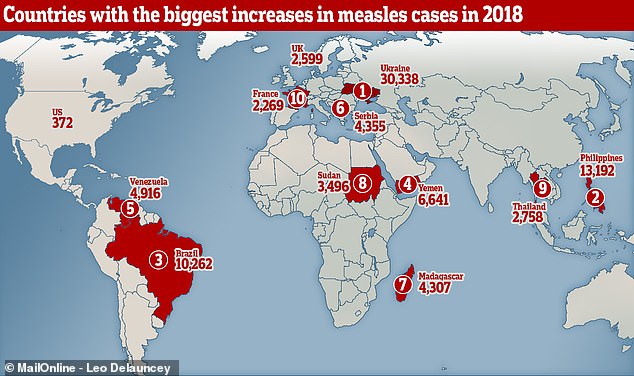
Europe saw over 82,000 measles cases in 2018, with 72 deaths across the region according to World Health Organisation (WHO) data, 3 times the reported number of cases in 2017 and 15 times the record low total of 2016.
Ukraine saw the largest number of measles cases in Europe out of any one nation- over 53,000 cases reported, 10 times the number of 2017. Serbia (5,076) and Israel (2,919) were the next two highest nations, followed by France (2,913), Italy (2,919), Russia (2,256), Georgia (2,203), Greece (2,193), Albania (1,466) and Romania (1,087). 92% of cases occurred in these 10 nations with the highest number of cases. Only 6 out of 53 countries in the European area had no reported measles cases, though only Tajikistan and Turkmenistan had populations over 400,000 of these nations.
In countries reporting hospitalization data, 61% of those with measles required hospitalization.
“The picture for 2018 makes it clear that the current pace of progress in raising immunization rates will be insufficient to stop measles circulation,” said Dr. Zsuzsanna Jakab, Director of the WHO’s European Regional Office. “We must do more and do it better to protect each and every person from diseases that can be easily avoided.”
The measles outbreak comes despite record high levels of vaccinations in the European area in 2017, the year in which 90% of children received the recommended second dose of the vaccine. According to the WHO, at least 95% of the population need to be immune (through two doses of the vaccine or previous exposure to the virus) to ensure ‘herd immunity’ for the at-risk community- including children too young to be vaccinated and those who cannot be vaccinated for other medical reasons.
Those infected with measles may have secondary complications, affecting their short and long term health. Britain’s National Health Service suggests about 1 in 5 children with measles experience complications such as pneumonia, ear infections, diarrhea and vomiting, meningitis, and eye disorders. There is also evidence to show that measles can lead to long term complications, including blindness, motor deficits, and partial paralysis. Long term, measles is believed to reduce the immune system of those infected, making them more prone to opportunistic infections for months to weeks after the infection, with an effect on the immune system that may last for several years. Empirical research has also demonstrated the long-term benefits of measles vaccination in preventing all-cause infectious disease.
A vaccine against measles has existed since the 1960s and the estimated cost to vaccinate a child is approximate $US 1. The WHO reports an estimated 80% drop in measles-related deaths since 2000 due to vaccination, with 21.2 million death prevented by measles vaccinations between 2000-2017.
Growing numbers of people dangerously refusing to vaccinate their children – anti-vaxxers – are one of the main reasons for the illness spreading. Children in the future could face ‘disastrous’ health problems if the deadly infection is allowed to spiral out of control. The number of people who caught measles last year rose by 50 percent worldwide, according to UNICEF 98 countries are reporting an increase.
Approximately 110 000 people died from measles in 2017 – mostly children under the age of 5 years, despite the availability of a cheap, safe and effective vaccine.
UNICEF – the United Nations’s children’s agency – has issued a warning that ‘complacency’ is leading to the rise.
Ukraine, the Philippines, and Brazil suffered the biggest increases in measles cases.
Brazil didn’t record a single case in 2018 but had 10,262 in 2018, while Ukraine saw an increase of more than 30,000 to a total of 35,120.
The other countries with the biggest increases were Yemen, Venezuela, Serbia, Madagascar, Sudan, Thailand, and France.
‘This is a wake-up call,’ said Henrietta Fore, executive director of UNICEF.
‘We have a safe, effective and inexpensive vaccine against a highly contagious disease — a vaccine that saved almost a million lives every year over the last two decades.
‘These cases haven’t happened overnight.
‘Just as the serious outbreaks we are seeing today took hold in 2018, lack of action today will have disastrous consequences for children tomorrow.’ Measles, which is most deadly for children, begins as a blotchy rash and fever and usually only lasts for a week or two, but it can be fatal. If untreated the virus can lead to life-threatening complications such as hepatitis, meningitis, nerve damage or brain swelling.
The number of children having MMR vaccinations – which are given free by the NHS in the UK – has been falling for years. Data in September last year revealed uptake in was at its lowest level since 2011 after falling for the fourth year in a row. Some 91.2 percent of children in England are being vaccinated, fewer than the 95 percent needed to stop the virus spreading through a community.
 Measles is more contagious than Ebola and, although it usually clears up on its own within a couple of weeks, can cause deadly complications like meningitis and pneumonia
Measles is more contagious than Ebola and, although it usually clears up on its own within a couple of weeks, can cause deadly complications like meningitis and pneumonia
And the World Health Organisation has said ‘vaccine hesitancy’ is one of the 10 most serious threats to global health.
‘Almost all of these cases are preventable and yet children are getting infected even in places where there is simply no excuse,’ said Ms. Fore.
‘Measles may be the disease, but all too often the real infection is misinformation, mistrust, and complacency.’
WHAT IS MEASLES, WHAT ARE THE SYMPTOMS AND HOW CAN YOU CATCH IT?
Also on WikiTribune: The comeback of vaccine-preventable diseases
Authors: James Chirgwin and Fiona Apps
Sources:
Monthly measles and rubella monitoring report, February 2019 – ECDC (pdf)
Measles in Europe: record number of both sick and immunized — WHO
Measles cases and MCV1 & MCV2 coverage in the WHO European Region, 2009 – 2018 — WHO
Infographic – Herd immunity: Fighting measles is a shared responsibility (2018) — WHO
Number of measles deaths by country, EU/EEA, 1 January 2018 to 31 December 2018 (n=34) — ECDC
Measles in Europe: infection rates highest in a decade, says UN health agency — UN News
Zsuzsanna Jakab, WHO Regional Director for Europe — WHO
Measles cases in Europe tripled last year, WHO says — BBC
Measles– A History of vaccines (from the College of Physicians of Philadelphia )




1 Comment
Pingback: Highbay